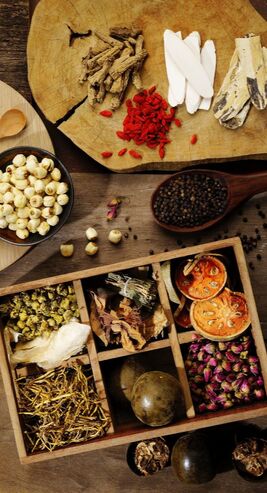Stroke Recovery Program
"Scalp acupuncture has shown a remarkable treatment efficacy on motor dysfunction in patients with stroke in China"
~ study from U.S. National Institute of Health's National Library of Medicine
What is Scalp Acupuncture?
Scalp acupuncture is a contemporary acupuncture technique which integrates traditional Chinese acupuncture with Western neurology in order to stimulate healing of representative areas of the cerebral cortex. It has been clinically demonstrated to be a most effective method for treating both acute and chronic brain and central nervous system disorders. Scalp acupuncture is known to produce remarkable results with few needles and in many cases brings about immediate improvement, often taking only seconds to see positive benefits.
Standard western medical treatment focuses on emergency care and reducing the risk of recurrence with drugs such as clot busting and blood pressure lowering medications. Post treatment involves physiotherapy. Scalp acupuncture and Chinese herbal therapies compliment standard medical treatments and physiotherapy as they focus on enhancing circulation and blood flow to damaged areas of the brain. Greater circulation to the brain is considered to promote faster and more complete recoveries.
Standard western medical treatment focuses on emergency care and reducing the risk of recurrence with drugs such as clot busting and blood pressure lowering medications. Post treatment involves physiotherapy. Scalp acupuncture and Chinese herbal therapies compliment standard medical treatments and physiotherapy as they focus on enhancing circulation and blood flow to damaged areas of the brain. Greater circulation to the brain is considered to promote faster and more complete recoveries.
"Scalp acupuncture often produces remarkable results with just a few needles and brings about immediate improvement sometimes taking
only several seconds to a minute" ~ National Center of Biotechnical Information
Yin-Wei (Vivi) McIndoe, RAC.
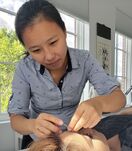
Vivi became instrested in focusing her training in stroke rehabilitation after her fathered a stroke leading to hemiplegia, dysphasia, spacticity and a host of other functional deficits. The devastating effects stroke had on her father and family inspired her to seek out the most effective treatments to treat the condition. This led her to learn scalp acupuncture which has been a well known stroke recovery therapy in Taiwan and China for many years. Her journey to master scalp acupuncture has led her around the world to learn from the very best doctors incorporating many theories into her own style to maximize results and bring the fastest and most powerful results to her patients.
Modern Masters of Scalp Acupuncture
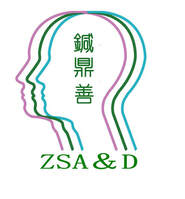
There are several of very well know doctors considered scalp acupuncture masters who have participated in the development of scalp acupuncture in the past 50 years. Vivi has recieved training in several styles of scalp acupuncture and trained directly under some of the most prominent of these brilliant innovators. Some of the more well know doctors and methods Vivi has learned include:
- Zhu’s Scalp Acupuncture which has been developed by Professor Ming Qing Zhu over the course of his 50 years of extensive clinical experience.
- Dr Wen Chong Kai who combines several methods and theories to attain superior results. Dr Wen maintains a very busy clinic in Taipei and lectures around the world.
- Dr Zhuang Yi Hsing who is both a neurologist and acupuncturist. Dr Zhuang practices a variation of New Yamamoto Scalp Acupuncture (NYSA) which he has combined with modern neurology to enhance clinical outcomes.
- Zhu’s Scalp Acupuncture which has been developed by Professor Ming Qing Zhu over the course of his 50 years of extensive clinical experience.
- Dr Wen Chong Kai who combines several methods and theories to attain superior results. Dr Wen maintains a very busy clinic in Taipei and lectures around the world.
- Dr Zhuang Yi Hsing who is both a neurologist and acupuncturist. Dr Zhuang practices a variation of New Yamamoto Scalp Acupuncture (NYSA) which he has combined with modern neurology to enhance clinical outcomes.
"Chinese herbal patent medicines significantly improved neurological function when compared with controls."
~ US Library of Medicine, National Institute of Health
~ US Library of Medicine, National Institute of Health
Herbal Medicine
|
Herbal Medicine has also been used for stroke recovery. Herbal medicine seeks to stimulate circulation and healing to the damaged area of the brain as well as regulating and balancing the overall body condition. Below are links to research studies demonstrating the effectiveness of herbal medicine in stroke recovery.
Formula: Bu Yang Huan Wu Tang "Tonify the Yang to Restore Five Tenths Decoction: Neuroprotective effects of Bu Yang Huan Wu decoction on cerebral ischemia-induced neuronal damage ~ US National Institute of Health Formula: Shu Xue Tong Traditional Chinese Formula Shu Xue Tong facilitates angiogenesis during would healing following traumatic brain injury. ~ PubMed.gov Some of the other formulas used to treat ischemic stroke include Xue Fu Zhu Yu Tang, Tong Qiao Huo Xue Tang, etc. |
An Overview Stroke / Cerebrovascular Accident
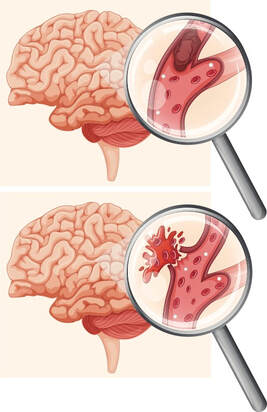
What causes a stroke?
A stroke occurs when the blood supply to part of your brain is interrupted or reduced, depriving brain tissue of oxygen and nutrients and occurs in two main ways.
Ischemic Stroke
First and most commonly occuring is ischemic stroke which occurs when arteries to the brain become too narrow or blocked resulting in severely reduced blood flow to brain tissue. Ischemic stroke accounts for about 80% of all cases of stroke. Ischemic stroke can be further divided into thrombotic stroke in whihch the clot forms in your brain and embolic stroke in which the clot forms elsewhere in the body and travels to the brain to lodge in the arteries resulting in ischemia.Hemorrhagic Stroke
Hemorrhagic Stroke
The second most predominant type of stroke occurs when a blood vessel in your brain ruptures causing blood to spill and pool in the brain tissue interrupting normal blood supply to brain tissue. Hemorrhagic stroke occurs in about 20% of cases.
A stroke occurs when the blood supply to part of your brain is interrupted or reduced, depriving brain tissue of oxygen and nutrients and occurs in two main ways.
Ischemic Stroke
First and most commonly occuring is ischemic stroke which occurs when arteries to the brain become too narrow or blocked resulting in severely reduced blood flow to brain tissue. Ischemic stroke accounts for about 80% of all cases of stroke. Ischemic stroke can be further divided into thrombotic stroke in whihch the clot forms in your brain and embolic stroke in which the clot forms elsewhere in the body and travels to the brain to lodge in the arteries resulting in ischemia.Hemorrhagic Stroke
Hemorrhagic Stroke
The second most predominant type of stroke occurs when a blood vessel in your brain ruptures causing blood to spill and pool in the brain tissue interrupting normal blood supply to brain tissue. Hemorrhagic stroke occurs in about 20% of cases.
Common Stroke Sequelae
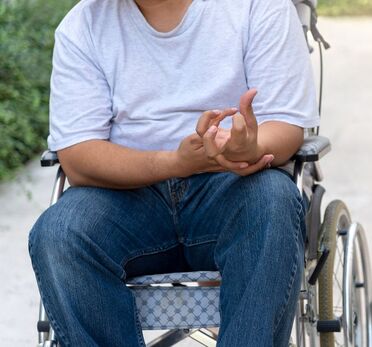
- Pain, numbness, tingling and burning sensations
- Paralysis, hemiplegia (one sided paralysis),
- Spacticity
- Fatigue, balance and coordination deficits
- Urinary or bowel incontinence
- Speech problems or difficulty understanding speech, reading, or writing.
- Memory, attention, and problem solving deficits
- Vision Problems
- Depression, anxiety, outbursts of anger
- Dysphagia or trouble swallowing

